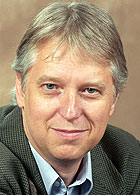Recent economic events have shaken the confidence of many Americans with respect to their ability to achieve the “American dream.” “With rising numbers of home foreclosures, job cuts, and loss of savings, more Americans are encountering severe periods of economic risk and insecurity in their lives,” says Mark R. Rank, Ph.D., poverty expert and professor of social work at Washington University in St. Louis.
 |
|
Mark R. Rank discussses the high risk of poverty in America and his research to help people avoid the risk.
|
Rank’s work is shedding a new light on the amount of economic risk that Americans face across their lifetimes. His work has shown that the likelihood of economic turmoil during one’s adulthood is exceedingly high, and has been rising over the past three decades.
For example, Rank’s research on the chances of encountering poverty has demonstrated that between the ages of 20 and 75, roughly three-quarters of all Americans will experience at least one year in poverty or near poverty. Even more surprising, two-thirds of Americans between the ages of 20 and 65 will, at some point, turn to a welfare program such as food stamps, and 40 percent of Americans will use a welfare program in five or more separate years during their working age adulthood. Additional analyses have shown that the life course risk of poverty has risen sharply from the 1970s to the 1990s.
Rank’s current research on homeownership has also revealed substantial turmoil in the lives of Americans. Although the vast majority of Americans will eventually buy a home — Rank estimates that by age 40, 83 percent of Americans have purchased a home — nearly 40 percent of these homeowners will lose their homeowner status within 10 years of the time of purchase. The recent home mortgage crisis has revealed substantial financial risk among American homeowners, and Rank’s life course work provides actual estimates of the amount of economic insecurity embedded within the dream of homeownership in America.
Another area of research that Rank, along with his collaborator at Cornell University, Tom Hirschl, has been investigating, is whether Americans have saved enough to get them through these periods of economic turmoil. Preliminary data analysis indicates that up to one half of all Americans will not have enough liquid assets to keep them out of poverty for three months should they suddenly lose their job.

Based on these and other analyses, Rank and Hirschl are developing a first-of-its-kind computer program and Web site that will allow Americans to estimate their degree of potential economic risk. The program will be analogous to current medical programs that allow individuals to calculate the likelihood of encountering a particular health risk such as heart disease.
“This program will not only allow individuals the capability to see into their economic future, but it will also allow them to understand the extent to which they might lower their risk by engaging in certain behaviors, such as acquiring more education,” Rank says.
Rank and Hirschl are currently putting together a book on economic insecurity and the American dream that will be forthcoming with Oxford University Press.
“All of this work is shedding light on the fragility of the ‘American dream’ and what we can do to restore its viability,” Rank says.